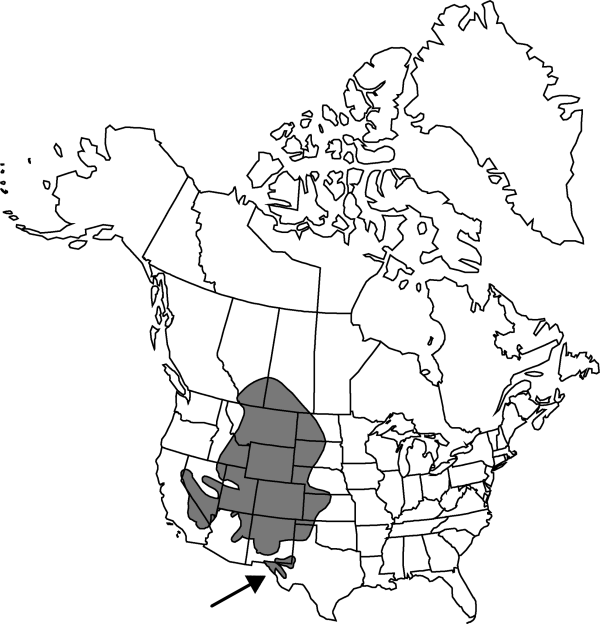Opuntia polyacantha
Suppl. Pl. Succ., 82. 1819.
Shrubs, low, 10–25 cm, with ± prostrate branches. Stem segments not easily detached, green, elliptic to narrowly to broadly obovate to circular, 4–27 × 2–18 cm, low tuberculate; areoles 4–14 per diagonal row across midstem segment, subcircular, 3–6 mm; wool tan to brown. Spines at all or only distal areoles of stem segment, terete to flattened, stout to acicular to bristlelike, straight to curling, of 1 or 2 kinds; if 1 kind: 0–18 per areole, spreading and curling in various directions, sometimes straight, erect, ascending to deflexed, yellow to dark brown to black, turning gray, pink-gray to gray-brown, longest (35–)40–90(–185) mm; if ± 2 kinds: major spines (0–)1–5, reflexed to porrect, yellow-brown to brown to gray, longest 20–150 mm; minor spines (0–)5–11, deflexed, white to white-gray, longest 4–16 mm. Glochids inconspicuous, in narrow, tidy crescent at adaxial edge of areole or in broad, brushy crescent and tuft, yellow to reddish, aging brown, to 10 mm. Flowers: inner tepals yellow to magenta throughout, 25–40 mm; filaments white, yellow, or red to magenta (flowers may superficially appear bicolored); anthers yellow; style white to pale pink; stigma lobes green. Fruits tan to brown, ± cylindric, 15–45 × 12–25 mm, dry at maturity, glabrous, sometimes burlike; areoles 10–33, each or only distal areoles bearing 3–16 spines, 4–20 mm. Seeds tan to gray, flattened, warped, oblong to subcircular, 3–7 × 2–4 mm; girdle protruding 1–2 mm.
Distribution

w United States, n Mexico.
Discussion
Varieties 5 (5 in the flora).
Populations of Opuntia polyacantha with spines few or absent (especially var. hystricina) were the basis for several names including O. juniperina, O. utahensis, and O. rhodantha.
Selected References
None.
Lower Taxa
Key
| 1 | Areoles 4-6 per diagonal row across midstem segment; stem segments 4-7 × 2-3(-5) cm, elliptic to very narrowly obovate; Texas, New Mexico, Mexico | Opuntia polyacantha var. arenaria |
| 1 | Areoles 6-14 per diagonal row across midstem segment; stem segments 6-27 × 5-18 cm, obovate to circular or, if elliptic, longer than 9 cm; widespread in w United States and Canada | > 2 |
| 2 | Spines of 2 kinds: major spines 1-3 per areole, usually deflexed on terminal stem segment, but sometimes ascending at stem segment apex; minor spines 1-3 per areole, deflexed, white, subtending major spines | > 3 |
| 2 | Spines of 1 kind, grading in length, from ascending to deflexed, 7-18 per areole, longest spines of terminal stem segment porrect to ascending, shorter spines deflexed to porrect | > 4 |
| 3 | Longest spines 2-4 cm; areoles 6-13 mm apart; stem segments 6-12 cm; Great Plains, n and e Great Basin Desert | Opuntia polyacantha var. polyacantha |
| 3 | Longest spines 4.5-12 cm; areoles 12-30 mm apart; stem segments 10-27 cm; Arizona and Utah border | Opuntia polyacantha var. nicholii |
| 4 | Spines usually dark brown, those of proximal stem segments like those of terminal stem segments, porrect to ascending, straight and stiff; fruit areoles 11-21, spiny but not burlike | Opuntia polyacantha var. hystricina |
| 4 | Spines usually pale, those of proximal stem segments not like those of terminals stem segments, more numerous, longer and more reflexed, straight or flexuous and/or hairlike or threadlike; fruit areoles 20-33, spiny, forming dense bur | Opuntia polyacantha var. erinacea |